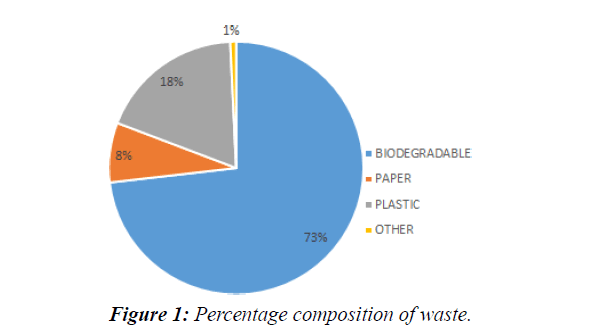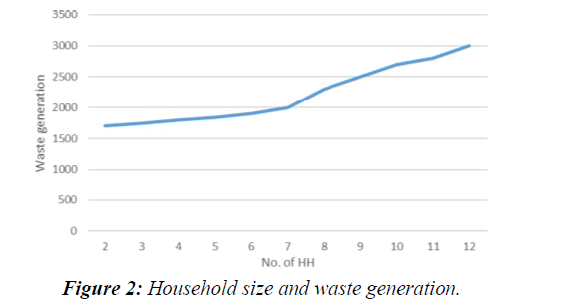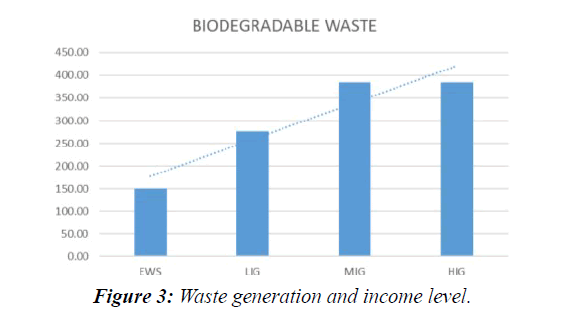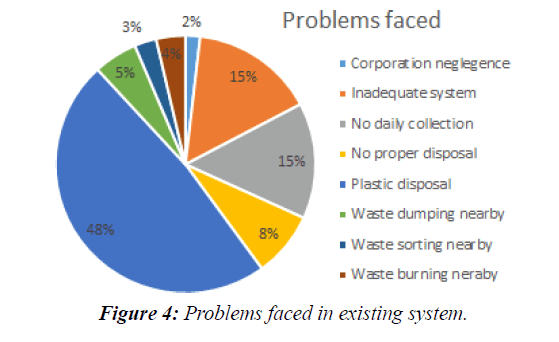Review Article - Journal of Environmental Waste Management and Recycling (2021) Volume 4, Issue 1
Decentralised Solid Waste Management for Kozhikode Corporation? A Sustainable Approach
K.Chithra, Shabana Yoonus*
Department of Architecture and Planning, National Institute of Technology, Calicut, India
- Corresponding Author:
- Shabana Yoonus
Department of Architecture and Planning
National Institute of Technology, Calicut, India
E-mail: shabanayoonud@yahoo.com
Accepted date: December 14, 2020
Citation: Chithra TK, Yoonus S. Decentralised solid waste management for Kozhikode corporation-A sustainable approach. Environ Waste Management Recycling. 2021;4(1):1-4.
Abstract
Solid waste management has become one of the major issues globally, especially in developing countries, due to environmental hazards, like air pollution, water pollution, soil pollution, greenhouse gas emission etc. In Kozhikode, currently waste is segregated and stored at origin, which is then collected and transported to Njelliyamparamba for windrow composting. However, segregation by households and waste collection by sanitation workers is not proper. Even the composting unit at Njelliyamparamba is not enough for handling all the waste collected. Finally, the rejects from the compost unit and non-biodegradable waste were dumped into landfills. Due to this, the neighboring areas have lot of problem regarding health, pollution etc. Objective of this paper is to identify the type and quantity of waste produced from which to find the gap in the existing system thereby develop a model for implementation which provide solution for the problems in a sustainable way The study aims to find solution for the solid waste management in an urban area in a sustainable approach.. The results shows that the per capita waste generation differs according to income, land use etc. the major gap in the existing system is in the waste collection and treatment, only a part of waste produced is collected out of which a part is only treated. In results part, it is also found the mostly preferred way of waste management technique is community level waste management. In conclusion, a sustainable Decentralised solid waste management system at community level is developed.
Keywords
Solid Waste Decentralised, Community Level, Sustainable Strategies.
Introduction
Solid waste management is an unresolved issue both for urban and rural area. However, according to the land use pattern and percentage built up it is a serious issue in urban areas. The solid waste and its issues start from the generation until the final disposal. The problems changes according to the type of waste, quantity of waste, type of origin and various other factors. Municipal Solid Waste is defined as any waste generated by household, commercial and/or institutional activities and is not hazardous. Depending upon the source, MSW is categorized into three types: Residential or household waste, commercial wastes and/or institutional wastes, municipal services wastes [1].
A Solid Waste Management (SWM) system includes the generation of waste, storage, collection, transportation, processing and final disposal [2]. All systems currently practiced will end up in landfills, which leads to many environmental issues. In this paper the type and quantity of waste produced and existing waste management, system is analysed to identify the gap and existing problems this led to solution that properly planned decentralised waste management at neighbourhood level with a combination of more than one method of waste management can efficiently handle the solid waste generated.
Research Objective
Solid waste management is an unresolved civic problem faced by all the districts of Kerala, and especially the urban areas, Kozhikode not being an exception. In accordance with the solid waste management rules, 2000, Kozhikode corporation has implemented a model solid waste management project. The wastes segregated at origin is collected and transported to the disposal site by Kudumbasree volunteers. There are severe planning problems in the each stage like no proper segregation; waste collection is not covering the entire corporation limits etc. The main problems at disposal site the capacity of the plant are 272 MTPD but due to environmental issues only 100 MTPD is only loaded. The increasing quantity of waste and environmental issues created by the existing system shows the need for decentralized sustainable solid waste management. The research objective of the paper is to identify the type and quantity of waste produced from which to find the gap in the existing system thereby develop a model for implementation which provide solution for the problems in a sustainable way.
Literature Review
The quantum of waste generated varies between 0.2 kg/capita/ day-0.4 kg/capita/day in urban cities and goes up to 0.5 kg/ capita/day in metropolitan cites [1]. This is estimated to increase at 1.33% annually. The total waste quantity generated by the year 2047 is estimated to be about 260 million tons per year. It is estimated that if the waste were not disposed of in a more systematic manner, more than 1,400 km2 of land, which is equivalent to the size of city of Delhi [3]. The total MSW generated in India, 30%-40% consists of organic waste, 30%- 40% ash and fine earth, 3%-6% paper while a meagre proportion of less than 1% accounts for plastics, glass and metals [1].
The main disposal techniques practicing in India are open dumping, landfilling, landfill gas to energy plants, biological treatment of organic waste, thermal treatment [4]. In Kerala, the idea is identification of a spot some distance away from urban centres and dumping of all the garbage there [5]. Furthermore, inadequate government funding and capacity (esp. trucks) to provide services. Initial costs and operation of conventional systems are very expensive. Lack of fee collection system and law enforcement on fees and fines, lack of training, equipment, capacities by local service providers, limited community awareness, limited to no waste separation before the final dumpsite, land limitations inhibiting the creation of new transfer stations and dumpsites, and unreliable solid waste management services results in illegal waste dumping and pollution are also the challenges [6].
Solid waste management can be made more efficient by proper planning, plan according to the type and quantity of waste, site suitable collection and transportation of waste, disposal and recycling, community participation etc. [7]. An optimization model including fixed cost like land cost, equipment cost and operating cost like transportation cost, labour cost etc. to identify a comprehensive disposal strategy. Considering segregation treatment and final disposal of MSW reveals that formation of clusters for segregation and treatment of MSW and final disposal at landfill site is more economical than segregation and disposal at each source towns/villages [8]. Integrated Solid Waste Management combines waste streams and waste collection, treatment and disposal methods with the objective of achieving environmental benefits, economic optimization and social acceptability. Such a waste management system will be environmentally, economically and socially sustainable, maintaining the fast-depleting natural resources with less harm [9].
The two leading innovative mechanisms of waste disposal being adopted in India include composting (aerobic composting and vermi-composting) and Waste-To-Energy (WTE) (incineration, palletisation, bio methanation) [10]. Aerobic composting reduces the volume of waste 50%-85% and converts it into fertilizers, which is non-odorous and free of pathogens. Manual composting is carried out in smaller urban centres and mechanical composting plants have been set up in big Indian cities [10]. Anaerobic digestion leads to energy recovery through biogas generation. The biogas, which has 55%-60% methane, can be used directly as a fuel or for power generation. It is estimated that by controlled anaerobic digestion, one of MSW produces 2-4 times as much methane in 3 weeks in comparison to what one t of waste in landfill will produce in 6-7 years [10]. Biogas systems can effectively handle localized and specific wastes and contribute to environment friendly disposal of wastes. Semi-mechanized aerobic composting can also be followed in small/medium towns. Mass incineration should be last option since it is not environment friendly but for hospital waste mass incineration can also be adopted [11]. In short, single households, restaurants, food courts and other sources of separated organic waste should be encouraged to employ smallscale bio methanation and use the biogas for cooking purposes. Use of compost product from mixed wastes for agriculture should be regulated. It should be used for gardening purposes only or as landfill cover. Rejects from the composting facility should be combusted in a waste-to-energy facility to recover energy. Ash from WTE facilities should be used to make bricks or should be contained in a sanitary landfill facility. Such a system will divert 93.5% of MSW from landfilling, and increase the life span of a landfill from 20 years to 300 years [2].
Methodology
The methodology broadly includes literature review and questionnaire survey. Literatures were reviewed to get the type, quantity of waste produced, current waste management system, waste management techniques and analysis techniques and for the formulation of questionnaire which is used for the household and commercial surveys for the collection of primary data regarding type and quantity of waste, current waste management techniques etc. From literature review and data from questionnaire survey, the gap and problems in the existing system were identified. The solutions to the waste management problems from a decentralised perspective were formulated considering the different waste management techniques.
Results and Discussion
Type and quantity of waste generated
The total quantity of waste generated is 0.5 kg per capita/day. The major components are biodegradable waste, plastic, paper, glass, iron, rubber. The percentage composition of waste is biodegradable 73%, plastic 18%, paper 8% and other 1% as shown in Figure 1.
Household size is directly proportional to waste generation. As the household size, increases the waste generation will also increases as shown in Figure 2. Income and waste generation are also directly proportional to each other, as income level increases waste generation also increases but it is found that while splitting the waste generation to biodegradable waste generation and plastic waste generation [7], High Income Grade (HIG) is less in biodegradable waste generation than Low Income Grade (LIG) as shown in Figure 3 which implies the use and throw culture of HIG.
Current waste management system
The major portion of biodegradable waste is collected by the sanitation workers 55% and the remaining will be either treated in biogas 2%, pipe compost 7%, or used as manure 19%, feeder for hen or cattle 7%, or dumped 2% or buried or will be burned 4%. Similarly, in case of non-biodegradable waste it will be either collected by agencies or burned or buried. The major threat found was 19% of plastic waste produced is burned which is a major environmental problem [11]. In the existing system, the major problem is the plastic disposal. The other problems are no proper disposal and collection of waste, the present system is inadequate for waste generated, burning or dumbing or sorting of waste near to their building.
Gap analysis
The existing facilities were compared with municipal solid waste management rules 2016 and IS standards to identify the gaps in the existing system. It was found that only 44% of generated waste is collected by the sanitation workers but according to municipal solid waste management rules 2016 it says that 100% of waste generated should be collected, which shows a gap of 56%.
Table 1: Gap analysis.
| Existing | Benchmark | Gap-existing | |
|---|---|---|---|
| Waste collection | 44% | 100% | 56% |
| Waste treatment | 67% | 100% | 33% |
Decentralised solid waste management system
The households will segregate the waste into biodegradable, plastic, paper etc. The biodegradable waste collection will be daily. Sanitation workers will further segregate the biodegradable waste as input to biogas unit and compost bin [10]. The slurry generated in biogas unit will be taken and added as inoculum to compost bin. The biogas generated will be supplied to the household in a manner one day to one house.
The compost from compost bin will be collected, cleaned, packed for selling by sanitation workers. Sweepings will also be added to the compost bin after segregating out plastic. If a community park is there in the association area it can be utilized for waste management, trench composting can be done with 7 pits, which will promote cleaned and spacious open area with nice vegetation.
Residents association and health inspectors will strictly enforce banning of usage of plastic carry bags even cancelling the license of shopkeeper. Make supply of paper bags and cloth bags produced under resident association unit to shops. All other plastic waste will stored, which can be used as an adhesive to road construction later or can be exported to Bangalore when there is a need in plastic to fuel plants. Installation of milk vending machine of Milma [7]. Minimize usage of plastic wrapped food items and promote cardboard or paper packed items by shop owners. The plastic waste collection will be held once in a month. For first collection, the amount payable will be according to quantity only. After that, high charge will be enforced if lower grade plastic waste is found. Sanitation workers will further sort the waste. Those, which can be utilized for value added product manufacturing, will be used for that remaining will be send to recycling unit. The paper waste also will be collected once in a month. It will utilize to make value added products. Remaining will be sold to shops. Paper waste, which cannot be used for any of this, will be shredded and added to compost bin.
Conclusion
The solid waste and its issues start from the generation until the final disposal. The existing solid waste management system in Kozhikode Corporation faces many problems like no proper segregation; capacity of plant is not enough, environmental issues due to landfill, no proper working environment for sanitation workers and no proper monitoring. The major problem faced is the disposal of plastic waste and lack of proper collection of waste. Only 44% of generated waste is collected by the sanitation workers out of which 67% of waste is being treated. 0.5 kg per capita per day is the present rate of waste generation but it is different for different income group and different land use. The most preferred waste management technique identified from primary survey is community level waste management but due time and space constraints, they are not practicing it presently. The study concludes with a decentralized solid waste management system at community level with combination of biogas plant and compost bin for the area. It do not have the environmental issues as of landfills i.e. bearable environment, it is economically profitable for all the stakeholders, i.e. economically viable and it is the easy, hygienic, equally distribute to all, i.e. socially equitable. Therefore, this model is a sustainable decentralized model for Kozhikode Corporation.
References
- Unnikrishnan H, Gowrav B, Jathanha S. Sustainable Decentralized model for solid waste management in urban India. 2006.
- https://gwcouncil.org/m-s-thesis-sustainable-solid-waste-management-in-india/
- https://ebtc-project.eu/index.php/knowledge-centre/publications-and-downloads-2008-2015/publications/environment-publications/162-market-reports-environment/257-the-solid-waste-management-sector-in-india-an-overview-of-research-and-activity
- Joshi R. Status and challenges of municipal solid waste management in India?: A review. Cogent Environ Sci. 2016;28:1-18.
- Harikrishnan G. Solid waste management: A comparative study between Kerala and Tamilnadu. Int J Res Soc Sci Humanit. 2014;2:29-37.
- http://www.innovationpolicyplatform.org/www.innovationpolicyplatform.org/system/files/4%20Integrated%20Waste%20Manangement_Apr6/index.pdf
- Vij D. Urbanization and Solid waste management in India: present practices and future challenges. Procedia-Soc Behav Sci. 2012;37:437-47.
- https://geagindia.org/stories-impact/water-sanitation-and-hygiene-wash/decentralized-solid-waste-management-through
- Pawels R, Tom AP. Assessment of technological options for solid waste treatment in Kerala. Int J Sci Res Publ. 2013;3:1-9.
- Sharholy M, Ahmad K, Mahmood G, et.al. Municipal solid waste management in Indian cities-A review. Waste Manag. 2208;28:459-57.
- Jain AP. Solid waste management in India urban solid waste. 1994.



